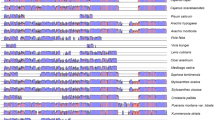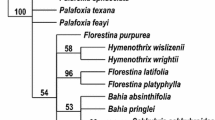Abstract
A phylogenetic analysis of Passifloraceae sensu lato was performed using rbcL, atpB, matK, and 18S rDNA sequences from 25 genera and 42 species. Parsimony analyses of combined data sets resulted in a single most parsimonious tree, which was very similar to the 50% majority consensus tree from the Bayesian analysis. All nodes except three were supported by more than 50% bootstrap. The monophyly of Passifloraceae s.l. as well as the former families, Malesherbiaceae, Passifloraceae sensu stricto, and Turneraceae were strongly supported. Passifloraceae s.s. and the Turneraceae are sisters, and form a strongly supported clade. Within Passifloraceae s.s., the tribes Passifloreae and Paropsieae are both monophyletic. The intergeneric relationships within Passifloraceae s.s. and Turneraceae are roughly correlated with previous classification systems. The morphological character of an androgynophore/gynophore is better used for characterizing genera grouping within Passifloraceae s.s. Other morphological characters such as the corona and aril are discussed.


Similar content being viewed by others
References
Alford MH (2005) Systematic studies in Flacourtiaceae. PhD dissertation, Cornell University
APG III (2009) An update of the angiosperm phylogeny group classification for the orders and families of flowering plants: APG III. Bot J Linn Soc 161:105–121
Arbo MM (2007) Turneraceae. In: Kubitzki K (ed) The families genera of vascular plants. Springer, Berlin
Bernhard A (1999) Flower structure, development, and systematics in Passifloraceae and in Abatia (Flacourtiaceae). Int J Plant Sci 160:135–150
Chase MW, Zmarzty S, Lledó MD, Wurdack KJ, Swensen SM, Fay MF (2002) When in doubt, put it in Flacourtiaceae: a molecular phylogenetic analysis based on plastid rbcL DNA sequences. Kew Bull 57:141–181
Cronquist A (1981) An integrated system of classification of flowering plants. Columbia Univ. Press, New York
De Wilde WJJO (1971) The systematic position of tribe Paropsieae, in particular the genus Ancistrothyrsus, and a key to the genera of Passifloraceae. Blumea 14:99–104
De Wilde WJJO (1974) The genera of tribe Passifloreae (Passifloraceae), with special reference to flower morphology. Blumea 22:37–50
Escobar LK (1988) Passifloraceae. In: Pinto P, Lozano G (eds) Flora de Colombia, Monografia No 10. Universidad Nacional de Colombia, Bogota
Farris JS (1989) The retention index and the rescaled consistency index. Cladistics 5:417–419
Fay MF, Swensen SM, Chase MW (1997) Taxonomic affinities of Medusagyne oppositifolia (Medusagynaceae). Kew Bull 52:111–120
Felsenstein J (1985) Confidence limits on phylogenies: an approach using the bootstrap. Evolution 39:783–791
Feuillet C, MacDougal JM (2007) Passifloraceae. In: Kubitzki K (ed) The families genera of vascular plants. Springer, Berlin
Gengler-Nowak KM (2002) Phenetic analyses of morphological traits in the Malesherbia humilis complex (Malesherbiaceae). Taxon 51:281–293
Gengler-Nowak KM (2003) Molecular phylogeny and taxonomy of Malesherbiaceae. Syst Bot 28:333–344
Hansen AK, Gilbert LE, Simpson BB, Downie SR, Cervi AC, Jansen RK (2006) Phylogenetic relationships and chromosome number evolution in Passiflora. Syst Bot 31:138–150
Hearn DJ (2006) Adenia (Passifloraceae) and its adaptive radiation: phylogeny and growth form diversification. Syst Bot 31:805–821
Hekking WHA (1988) Flora Neotropica Monograph 46, Violaceae Part I—Rinorea and Rinoreocarpus. New York Botanical Garden, New York
Huelsenbeck JP, Ronquist F (2001) MrBayes: Bayesian inference of phylogenetic trees. Bioinformatics 17:754–755
Hutchinson J (1967) Passifloraceae: the genera of flowering plants, vol 2. Clarendon Press, Oxford
Korotkova N, Schneider JV, Quandt D, Worberg A, Zizka G, Borsch T (2009) Phylogeny of the eudicot order Malpighiales: analysis of a recalcitrant clade with sequences of the petD group II intron. Plant Syst Evol 282:201–228
Krosnick SE, Freudenstein JV (2005) Monophyly and floral character homology of Old World Passiflora (subgenus Decaloba: supersection Disemma). Syst Bot 30:139–152
Krosnick SE, Ford AJ, Freudenstein JV (2009) Taxonomic revision of Passiflora subgenus Tetrapathaea including the monotypic genera Hollrungia and Tetrapathaea (Passifloraceae), and a new species of Passiflora. Syst Bot 34:375–385
Kubitzki K (2007) Malesherbiaceae. In: Kubitzki K (ed) The families genera of vascular plants. Springer, Berlin
Maddison DR, Maddison WP (2003) MacClade 4.08 for MacOS X. Analysis of phylogeny and character evolution. Sinauer. Sunderland, Massachusetts
Mason-Gamer RJ, Kellogg EA (1996) Testing for phylogenetic conflict among molecular data sets in the tribe Triticeae (Gramineae). Syst Biol 45:524–545
Melchior H (1925) Violaceae. In: Engler A, Prantl K (eds) Die natürlichen Pflanzenfamilien, 2nd edn, vol 21. Wilhelm Engelmann Leipzig, Germany
Muschner VC, Lorenz AP, Cervi AC, Bonatto SL, Souza-Chies TT, Salzano FM, Freitas LB (2003) A first molecular phylogenetic analysis of Passiflora (Passifloraceae). Am J Bot 90:1229–1238
Nylander JAA (2004) MrModeltest, version 2. Computer program distributed by the author. Evolutionary Biology Centre. Uppsala University, Uppsala
Rambaut A, Drummond AJ (2003–2009) Tracer, version 1.5, MCMC trace analysis package. http://tree.bio.ed.ac.uk/software/tracer/
Ronquist F, Huelsenbeck JP (2003) MrBayes 3: Bayesian phylogenetic inference under mixed models. Bioinformatics 19:1572–1574
Savolainen V, Fay MF, Albach DC, Backlund A, van der Bank M, Cameron KM, Johnson SA, Lledó MD, Pintaud JC, Powell M, Sheahan MC, Soltis DE, Soltis PS, Weston P, Whitten WM, Wurdack KJ, Chase MW (2000) Phylogeny of the eudicots: a nearly complete familial analysis based on rbcL gene sequences. Kew Bull 55:257–309
Simmons MP, Müller K, Norton AP (2007) The relative performance of indel-coding methods in simulations. Mol Phylogenet Evol 44:724–740
Soltis DE, Soltis PS, Chase MW, Mort ME, Albach DC, Zanis M, Savolainen V, Hahn WH, Hoot SB, Fay MF, Axtell M, Swensen SM, Prince LM, Kress WJ, Nixon KC, Farris JS (2000) Angiosperm phylogeny inferred from 18S rDNA, rbcL, and atpB sequences. Bot J Linn Soc 133:381–461
Soltis DE, Gitzendanner MA, Soltis PS (2007) A 567-taxon data set for Angiosperms: the challenges posed by Bayesian analyses of large data sets. Int J Plant Sci 168:137–157
Swofford DL (2001) PAUP: phylogenetic analysis using parsimony, ver 4.0b10. Sinauer. Sunderland, Massachusetts
Takhtajan A (1997) Diversity and classification of flowering plants. Columbia Univ. Press, New York
Tokuoka T (2007) Molecular phylogenetic analysis of Euphorbiaceae sensu stricto based on plastid and nuclear DNA sequences and ovule and seed character evolution. J Plant Res 120:511–522
Tokuoka T (2008) Molecular phylogenetic analysis of Violaceae (Malpighiales) based on plastid and nuclear DNA sequences. J Plant Res 121:253–260
Tokuoka T, Tobe H (2006) Phylogenetic analyses of Malpighiales using plastid and nuclear DNA sequences, with particular reference to the embryology of Euphorbiaceae sens. str. J Plant Res 119:599–616
Wurdack KJ, Davis CC (2009) Malpighiales phylogenetics: gaining ground on one of the most recalcitrant clades in the angiosperm tree of life. Am J Bot 96(8):1551–1570
Acknowledgments
I am grateful to the curators of MO, L, and KYO for their assistance in obtaining the materials used in the study, and Dr. Johannes Lundberg, at Swedish Museum of Natural History, for valuable comments and suggestions on this paper. I also thank two anonymous reviewers. The study was supported by a Grant-in-Aid for Scientific Research from the Japan Society for the Promotion of Science (20570086).
Author information
Authors and Affiliations
Corresponding author
Electronic supplementary material
Below is the link to the electronic supplementary material.
Rights and permissions
About this article
Cite this article
Tokuoka, T. Molecular phylogenetic analysis of Passifloraceae sensu lato (Malpighiales) based on plastid and nuclear DNA sequences. J Plant Res 125, 489–497 (2012). https://doi.org/10.1007/s10265-011-0472-4
Received:
Accepted:
Published:
Issue Date:
DOI: https://doi.org/10.1007/s10265-011-0472-4




